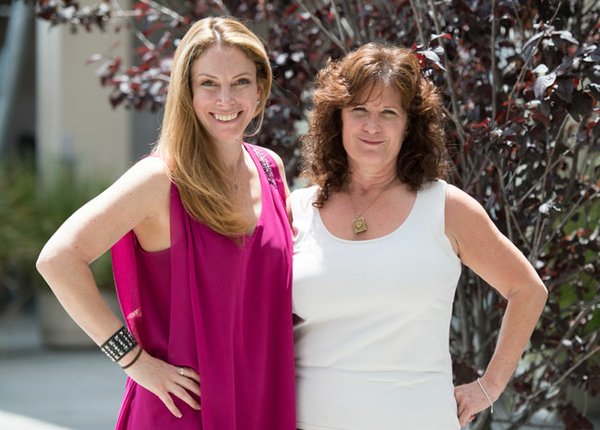Staci Riordan (left), director of the Fashion Law Project at Loyola Law School, and Deborah Greaves (right), founder of Label Law and former general counsel at True Religion, gave presentations on intellectual property at the law school’s first Summer Intensive Fashion Law Program. Other topics at the week-long seminar included employment law, importing and exporting, advertising and social media, licensing, building brand value, and the use of celebrities. (Photos courtesy of Kim Fox Photography)
FASHION LAW 101
Loyola Hosts First Summer Intensive Fashion Law Program
Launching a fashion business—or running an already successful one—is hard enough. The last thing a designer or executive needs is to run into trouble on the legal end, but with the industry becoming increasingly global—and, as a result, laws from not just the United States but from countries around the world coming into play—an understanding of legal nuances is becoming more important than ever.
With that in mind, Loyola Law School in Los Angeles formed the Fashion Law Project, an academic center dedicated to the unique legal issues facing the fashion industry, both domestically and internationally. In an effort to help both lawyers and fashion-industry professionals further specialize their knowledge of how the law affects the industry’s business operations, the Fashion Law Project hosted its first-ever Summer Intensive Program July 24–Aug. 1.
About 50 percent of the attendees were attorneys who work with the fashion industry, said Staci Jennfier Riordan, director of the Fashion Law Project and partner and chair of the Fox Rothschild Fashion Law Practice Group. The other half was split between designers and industry executives. Riordan’s goal is for the designers and executives attending to come away with an increased awareness of the legal issues involved—or, just as importantly, the potential issues—with their business. “Your chances of success are exponentially better,” Riordan said, when people are aware of how to protect themselves and their business. “If you know enough to ask the right questions, I’ve done my job,” she said.
An example of the importance of increased awareness would be two best friends who go into business together without hammering out a written agreement planning for various paths the company might take in the future. Some might think of such an agreement as planning for failure, but Riordan said it should be thought of as the opposite. She described the scenario as “What happens if we become super-successful and one of us wants to leave and the other wants to keep working?”
For the attorneys attending, the seminar was an opportunity to learn more about the fashion industry itself. “If you don’t understand the industry, you’re not going to be the best [lawyer] you can be,” Riordan said. A big example, she said, is the importance of filing for trademark protection well in advance, which is the opposite of other industries. But because of the nature of the fashion industry, trademarks are, in general, more applicable than copyrights or patents for fashion, she said.
The U.S. Patent and Trademark Office defines a trademark as “a word, phrase, symbol and/or design that identifies and distinguishes the source of the goods of one party from those of others.” Ironically, the theoretical purpose of a trademark, Riordan said, is for protection for the consumer, not the business itself—so that the consumer knows whom to sue if something goes wrong.
Unlike a trademark, the theoretical purpose for a copyright is to protect the creator by giving an incentive to create. (The U.S. Copyright Office says a copyright is for “original works of authorship fixed in a tangible medium of expression.”) However, Riordan said, there are “so little” things that copyright law covers in fashion. (Jewelry and belt buckles have copyright protection because they’re separable, she said.)
Patents, which are property rights specifically for an invention, are rare in fashion, although handbags and shoes are more likely to acquire them, Riordan said.
When designers are creating their brand, they should be thinking about trademark implications and be aware of how the mark might be problematic in another country, said Deborah Greaves, founder of Label Law and former general counsel at True Religion, who led one of the presentations. With a global economy, “the days are gone when you can bench your success solely on [presence] in the United States,” she said. “When you adopt a mark, it’s important to think of a global application. Some words, such as ‘Buddha’ or ‘religion,’ could give you a problem in some countries. I would know,” Greaves said.
When True Religion attempted to register its mark in China, the Chinese government denied True Religion’s trademark application because of its use of the word “religion.” The registration was an eight-year process, which involved the help of a linguistics expert from Yale University as well as Vice President Joe Biden, Greaves said. The process even included a comparison between how the Chinese trademark office was translating the name of True Religion and how the company’s name was coming up in Chinese on various Internet search engines. The characters that the Chinese trademark office were initially using to identify “True Religion” translated to “True Organized Cultish Belief” in English. Greaves argued that Internet search results showed that Chinese consumers who were writing about True Religion online were using characters that translated to “True Belief.”
“We were running out of options. We had to go outside the box,” Greaves said.
Think globally
Another example of the importance of not getting caught off-guard: You appear at a trade show with your new brand and later attempt to register your trademark in Korea—only to find out that somebody walking the show floor already registered your trademark.
“You have pirates who walk trade shows. It’s a pattern. It’s a business. They hold your trademark hostage, and they sell it to you,” Greaves said. “It’s the same with China—and sometimes even worse. They have first-to-file rules,” she said. At this point, it would take money and time to fight it. “It’s easier and relatively cheaper to just file overseas in the first place.”
Companies that don’t have a strategic plan in advance for IP registration overseas are giving themselves a “big problem,” according to Greaves, especially considering the global economy.
Plus, having overseas IP registration helps build brand value, Greaves said, and can even help avoid problems with potential investors. If a company has pending IP lawsuits overseas, she said, “nobody wants to buy into that.”
Companies should plan ahead far in advance—“as soon as you think of launching your brand,” according to Riordan—and consider both distribution and manufacturing when putting together the list of countries in which to apply for trademark registration. Generally, Greaves and Riordan said, the list of possibilities should include the U.S., Korea, China, Mexico, Japan, Australia and the European Union.
“It’s really disheartening to build up a brand in the U.S. but you can’t sell it in the EU because someone already registered it there,” Greaves said. “Infringement laws in Europe are very strong. They’re even stronger than the U.S.”
Therefore, even during the early stages of developing a brand name, check overseas in advance to see which names have already been registered.
“It’s expensive, but it’s worth it,” she said.
When it comes to protecting your brand name, anti-counterfeiting should be proactive, not reactive, Greaves stressed, pointing out Apple as a company that has been extremely proactive in its international IP protection.
“Their portfolio [of international trademarks] is vast,” she said.
Also consider filing early in Russia because, according to Greaves, that country’s organized crime has created a “real hotbed for counterfeit.” If you plan on manufacturing in Haiti, India, Bangladesh or Colombia, apply for registration in those countries far in advance.
Greaves also pointed out the importance of planning for contingencies. Even if you don’t have any plans on selling or manufacturing in China, you should still strongly consider filing a trademark application there just in case.
“China is rife with problems for the apparel industry,” Greaves said, but trademark registration can help.
True Religion was able to get Chinese authorities to conduct raids of factories making counterfeit merchandise because the company had the proper trademark registration with the Chinese government, she said.
Likeliness of confusion
When it comes to evaluating actual claims of trademark infringement, U.S. courts use the test of “likelihood of confusion” among consumers. Riordan cited AMF Inc. v. Sleekcraft Boats as a set of standards for “likelihood of confusion” used by the U.S. Court of Appeals for the Ninth Circuit (which includes California) and Polaroid Corp. v. Polarad Elect. Corp. as the standards used by the U.S. Court of Appeals for the Second Circuit (which includes New York).
Riordan also cited Qualitex Co. v. Jacobson Products Co. Inc. as a key U.S. Supreme Court decision from 1995 regarding the use of color in trademarks. Qualitex manufactured dry-cleaning pads in a specific shade of green gold and sued rival company Jacobson Products after it began using a similar shade on its own press pads. The Ninth Circuit had ruled against Qualitex’s claim of trademark infringement, saying that color alone does not meet the requirements for a trademark. However, the U.S. Supreme Court disagreed, saying that the shade of green gold identifies and distinguishes the goods from those from another company. In addition, the U.S. Supreme Court said that the color was a nonfunctional element to the use of the product. (Certain features of a product that contribute to the actual function of the product might not be eligible for a trademark, according to U.S. law.)
A more recent and fashion-related example of the trademarking of color that Riordan discussed was the saga of Christian Louboutin’s lawsuits against Zara and Yves Saint Laurent regarding the use of red on the soles of their shoes. Riordan discussed two reasons for why the Louboutin company did not get the results it was looking for in court. First, Louboutin himself didn’t emphasize that the specific reason his company used red on the soles of its shoes was to distinguish the brand from others, a key principle of trademark law. And, besides, Riordan said, it is unlikely that a consumer would mistake the Zara shoe for a Louboutin shoe, even with the red soles. “He didn’t pick a very good target,” Riordan said.
Second, according to Riordan, Louboutin said in a deposition that he believed the use of any shade of red—not just his specific red—on the sole of a shoe should be considered a violation of his trademark.
On the other hand, Tiffany & Co. has a trademark specifically for its shade of blue because the shade is extremely specific. (It’s produced as a custom color by Pantone, with a specific Pantone number, exclusively for Tiffany.)
The two lessons, Riordan said, are to pick your battles wisely and to be specific in your trademarks. If Louboutin’s trademark had been more specific, Riordan said, “it might have come out differently.”
Other topics in Loyola’s Summer Intensive Program included employment law, importing and exporting, advertising and social media, licensing, building brand value, and the use of celebrities. The legal categories that apply to fashion obviously already exist as their own (such as intellectual property, employment, contracts, etc.), but Riordan sees a specific niche for fashion law continuing to be developed at law schools and in the legal community. “It’s going to be like entertainment law in the next 20 years,” she said.
For more about the Fashion Law Project, visit www.lls.edu/fashionlaw.

























